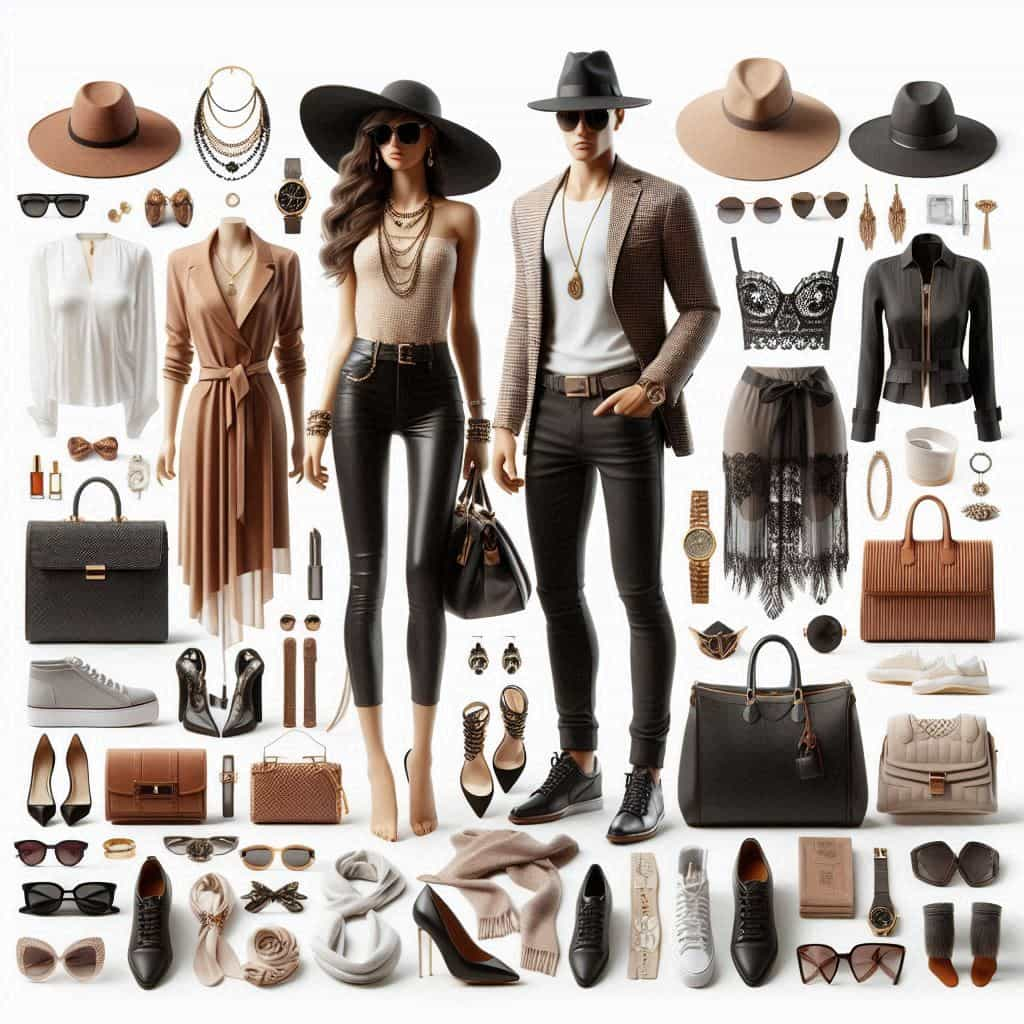
Fashion doesn’t have to be complicated. With a few key strategies, you can make the most of neutral colors, choose the right accessories, and organize your wardrobe to look stylish every day. Whether you’re dressing up for a special occasion or just putting together a casual outfit, mastering these elements will simplify your fashion routine and keep you looking sharp.
How to Make the Most of Neutral Colors in Fashion
1. Embrace the Power of Neutrals
Neutral colors like black, white, gray, beige, and navy are the foundation of a versatile wardrobe. Here’s why they’re essential:
- Versatility: Neutrals can be easily mixed and matched with almost any color.
- Timeless Appeal: They never go out of style and can be dressed up or down.
- Easy to Coordinate: Neutrals make it simple to create outfits that look put-together.
2. Build a Balanced Wardrobe
To maximize neutrals:
- Start with Basics: Invest in essential pieces like a white shirt, gray trousers, and a black blazer.
- Add Variety: Incorporate different shades of neutrals for added depth and interest.
3. Use Neutrals as a Base
Neutral colors work best as a base layer:
- Pair with Bold Colors: Combine neutral pieces with statement colors or patterns to create a balanced look.
- Layering: Use neutrals in your layering pieces, such as cardigans or jackets, to keep your outfit grounded.
Choosing the Right Accessories for Your Outfits
1. Understand Your Outfit’s Needs
Accessories can make or break an outfit. Here’s how to choose:
- Match the Form: Formal outfits need elegant accessories like watches and cufflinks, while casual outfits can be enhanced with simpler pieces like bracelets and caps.
- Balance the Look: Avoid over-accessorizing. Choose a few standout pieces to complement your outfit without overwhelming it.
2. Essential Accessories for Every Wardrobe
Invest in these timeless accessories:
- A Classic Watch: Perfect for adding a touch of sophistication to any outfit.
- Neutral Belts: Useful for both casual and formal wear.
- Quality Shoes: A good pair of shoes can elevate your look instantly.
Organizing Your Wardrobe for Maximum Efficiency
1. Categorize and Declutter
A well-organized wardrobe saves time and reduces stress:
- Sort by Category: Divide clothes into categories like casual, work, and formal wear.
- Declutter Regularly: Remove items that no longer fit or haven’t been worn in the last year.
2. Use Smart Storage Solutions
Effective storage can simplify your wardrobe:
- Hanging vs. Folding: Hang delicate or formal items and fold casual wear like sweaters.
- Clear Storage Bins: Use labeled bins or clear boxes for seasonal items and accessories.
How to Layer Clothes Like a Pro
1. Start with a Solid Foundation
Layering effectively starts with the basics:
- Base Layer: Use a fitted t-shirt or shirt as your base layer.
- Middle Layer: Add a sweater, cardigan, or vest for warmth and style.
2. Finish with Outerwear
Complete your look with an outer layer:
- Seasonal Jackets: Choose a light jacket for spring or a heavy coat for winter.
- Blazers: A blazer can be used to dress up casual outfits or add structure to a relaxed look.
Mixing and Matching Different Fashion Styles
1. Blend Casual and Formal
Mixing styles can create unique and interesting outfits:
- Casual with Formal: Pair jeans with a blazer or a dress shirt with sneakers.
- Balance: Ensure one part of your outfit is more formal and the other is casual to avoid clashing.
2. Experiment with Patterns and Textures
Add depth to your look by combining patterns and textures:
- Patterns: Try pairing striped shirts with plaid trousers for a stylish twist.
- Textures: Combine denim with leather or knitwear for a more dynamic outfit.
How to Coordinate Outfits for a Cohesive Look
1. Stick to a Color Scheme
A consistent color scheme ties your outfit together:
- Choose a Palette: Pick a few colors that complement each other and stick to them.
- Accent Colors: Use accent colors to add pops of interest without overwhelming the main palette.
2. Match the Occasion
Coordinate outfits based on the event:
- Casual Events: Opt for comfortable and relaxed outfits.
- Formal Events: Choose polished and elegant attire.
Dressing Efficiently Without Sacrificing Style
1. Plan Your Outfits
Save time and stay stylish:
- Weekly Planning: Set aside time each week to plan your outfits.
- Daily Prep: Lay out your clothes the night before to streamline your morning routine.
2. Keep a Go-To List
Have a list of reliable outfits for various occasions:
- Work Uniform: Have a set of go-to work outfits that are both professional and comfortable.
- Casual Staples: Maintain a selection of casual outfits that are easy to mix and match.
Minimalist Accessories for the Modern Man
1. Choose Quality Over Quantity
Focus on essential pieces:
- Sleek Watches: Opt for a timeless design that complements both casual and formal wear.
- Simple Jewelry: A classic ring or bracelet can add a touch of elegance without being flashy.
2. Invest in Versatility
Select accessories that work with multiple outfits:
- Neutral Colors: Choose accessories in neutral colors to match a wide range of outfits.
- Timeless Designs: Invest in classic styles that won’t go out of fashion quickly.
Making a Statement with Bold Fashion Choices
1. Select One Statement Piece
A bold fashion choice can make a strong impression:
- Statement Shoes or Jackets: Opt for a standout piece that adds personality to your outfit.
- Patterned Accessories: Use bold patterns or colors to draw attention.
2. Balance the Look
Ensure your statement piece doesn’t overwhelm:
- Keep It Simple: Let the statement piece be the focal point by keeping the rest of your outfit simple.
- Complementary Colors: Choose accessories that enhance rather than clash with your statement piece.
Discovering and Refining Your Personal Style
1. Experiment with Different Looks
Finding your style involves trying new things:
- Try Trends: Experiment with various styles to see what suits you best.
- Seek Inspiration: Look at fashion blogs or magazines for ideas and trends.
2. Define and Refine
Once you discover your style:
- Build a Wardrobe: Invest in key pieces that reflect your personal style.
- Consistency: Maintain a consistent look that feels authentic to you.
The Fundamentals of Men’s Fashion: What You Need to Know
1. Understand the Basics
Start with foundational pieces:
- Fit Matters: Ensure your clothes fit well. Ill-fitting clothes can ruin a great look.
- Essentials: Build your wardrobe with classic items like well-fitting jeans, a tailored blazer, and versatile shirts.
2. Add Variety and Personality
Once you have the basics:
- Incorporate Trends: Add trendy pieces to keep your wardrobe current.
- Personal Touch: Include items that reflect your unique style and preferences.
Quick Tips for Choosing Outfits on the Go
1. Stick to What You Know
When in a rush:
- Reliable Outfits: Have a few go-to outfits that you know work well together.
- Color Coordination: Choose colors that easily mix and match.
2. Plan for Versatility
Select pieces that can be quickly adapted:
- Layering: Use layers that can be added or removed depending on the weather or occasion.
- Multipurpose Items: Opt for items that work for multiple situations, like a blazer that can be dressed up or down.
How to Build a Capsule Wardrobe from Scratch
1. Start with Essentials
A capsule wardrobe focuses on versatile pieces:
- Core Items: Begin with basics like neutral t-shirts, jeans, and a versatile jacket.
- Add Variety: Include a few items for special occasions or to add variety.
2. Maintain Quality and Fit
Focus on high-quality items that fit well:
- Invest in Quality: Choose durable, well-made items that will last.
- Tailoring: Make sure everything fits properly for a polished look.
Casual Clothing Essentials for Every Man
1. Build a Strong Foundation
Essentials for a casual wardrobe:
- Well-Fitting Jeans: Comfortable and versatile.
- Casual Shirts: Include t-shirts and casual button-downs.
- Comfortable Shoes: Sneakers or loafers that work with various outfits.
2. Add Layering Options
Include items for different weather conditions:
- Light Jackets: Ideal for layering during cooler weather.
- Sweaters: Perfect for added warmth and style.
How to Transition from Casual to Smart Casual Effortlessly
1. Combine Casual and Formal Elements
Create a smart casual look by blending styles:
- Casual Pants with a Blazer: Pair casual trousers with a tailored blazer.
- Smart Shoes: Opt for loafers or dress shoes instead of sneakers.
2. Accessorize Wisely
Use accessories to elevate your look:
- Dressier Accessories: Choose a leather belt or a sleek watch to add sophistication.
- **Subtle Adjustments:** Make small changes to transform a casual outfit into smart casual.
By understanding how to utilize neutral colors, choosing the right accessories, and mastering wardrobe organization, you’ll simplify your fashion routine and look effortlessly stylish. Embrace these tips to enhance your daily dressing experience and showcase your best self every day.








